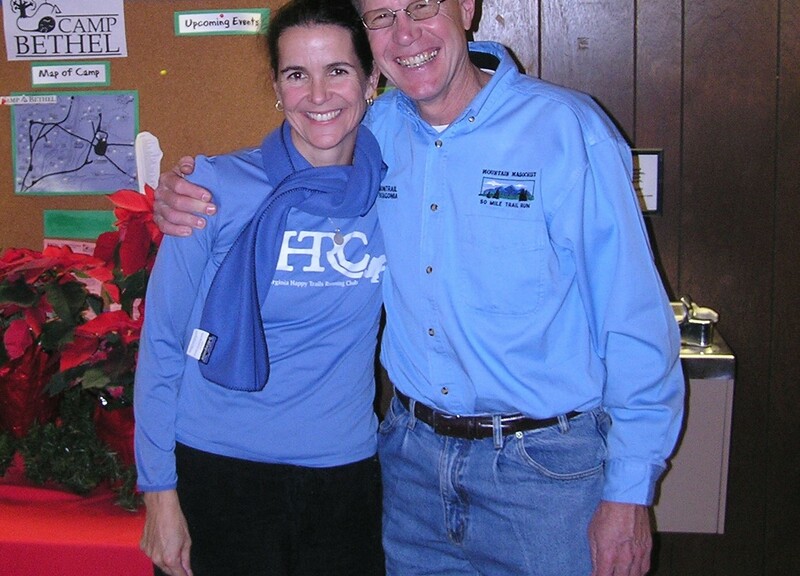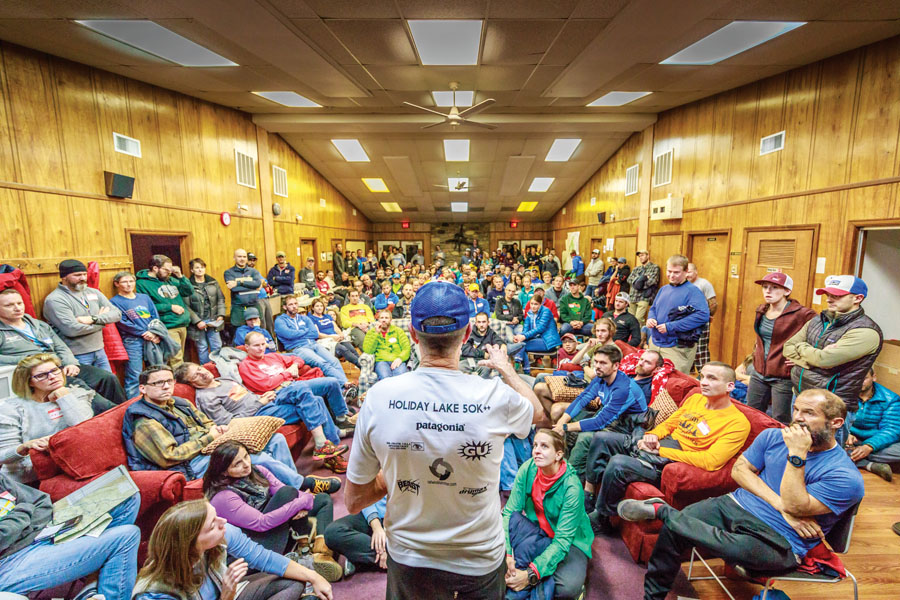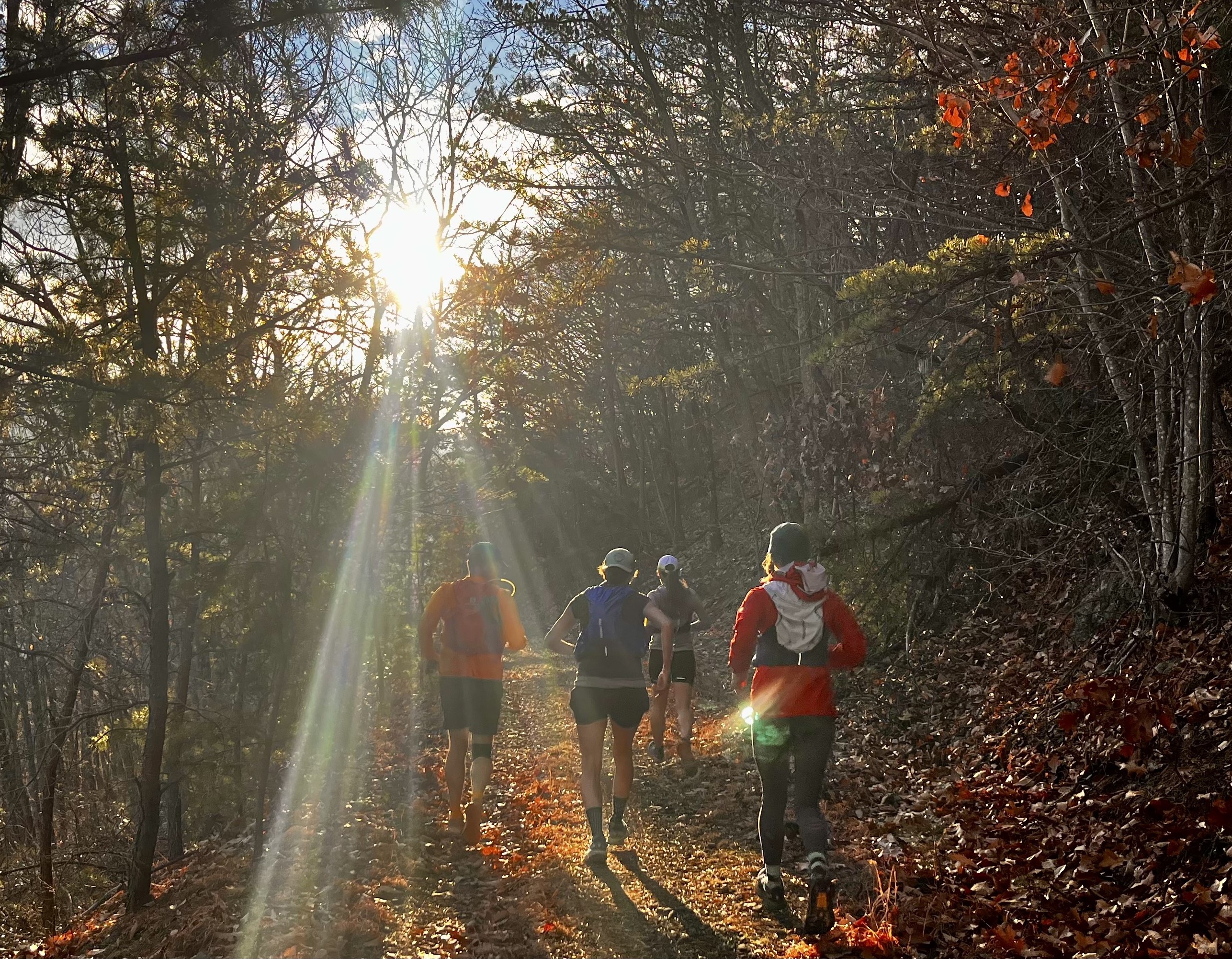
Hellgate 100K: 20 Years of Heaven, Hell, and Horton Miles
“Crossing the finish line just more than 17 hours after I began the Hellgate 100K, race director David Horton asked me if he should host the run again and if I would run it next year if offered. Twenty-four hours later I’m still not sure. Hellgate was probably the most incredible running adventure of my life. It has everything that I’ve come to love in our sport — rugged mountains, fast-flowing streams, waterfalls in the middle of nowhere that few ever see, incredible views, and a level of insanity that sets us apart from road runners.” – Jaret Seiberg, in his post-Hellgate report from 2003.
In December 2003, a new ultra in the Blue Ridge Mountains of Virginia debuted to much fanfare in our local ultra community. The brainchild of David Horton, and enabled by Charlie Hesse and Dr. George Wortley, the Hellgate 100K started on the second Saturday of December, at precisely 12:01am, at the trailhead of the Glenwood Horse Trail near Glasgow. Weaving past landmarks such as Devil’s Marbleyard and Big Hellgate Creek, and crossing the Appalachian Trail and Blue Ridge Parkway in four different places, the race connected together sections of the Promise Land 50K and Terrapin Mountain 50K, and at the time (pre-GPS), measured out to be “approximately 62 miles” according to David (note: GPS now measures the course to be between 66.6 and 70 miles).
That first year, seventy-one hardy souls started the race in 20 degree temperatures with iced-over trails and fire roads. Forty runners finished under the 18-hour cut-off for a 62% finishing rate, the second-lowest in its history, and runners like Jaret Seiberg wondered if the race would even continue, given its challenging weather and travel obstacles for crews. 2003 was also the year that the VHTRC began its deep connection with the race: Aaron Schwartzbard, author of the definitive guide to running Hellgate, finished second overall, and began a 21-year finish streak at Hellgate along with four other runners, aka the “Fearsome Five”: Ryan Henry, Darin Dunham, Jeffrey Garstecki, and Jerry Turk. Gary Knipling was the only finisher over 60, and Keith Knipling completed the first of his ten finishes that inspired him to create a handy guide to all things Hellgate in 2007.
My own love affair with the race began in 2005, also known as the “Ice Year.” It was early in my ultra career, and I was eager to experience what everyone had been talking about, as by then the race had become legendary for its intimate feel, challenging weather, and a tough section of rocky, leaf-covered trail that I later named “The Devil Trail.” Two days before the race, central Virginia was hit with an ice storm that covered the course with ice and 4-6 inches of snow. Many runners, including myself, wore traction devices the entire race, and we didn’t see dirt until the turn into Camp Bethel at the finish. Although the snow covered all the rocks and leaves, it also started to melt in the last, never-ending section that Aaron had dubbed “The Forever Section” which created a brutal slip-and-slide after running 55 miles. Afterward, many of the VHTRC gang spent the night in the Camp Bethel lodge (which is still a free perk for runners and crew), celebrating with post-race homemade chili, a birthday cake for Vicki Kendall and me, and telling stories late into the night. It was an exhilarating mountain adventure with a bunch of new and old friends, and I was hooked. [Editor’s Note: Here is Sophie’s report from that 2005 race.]
As the years went by, more and more runners made Hellgate part of their race calendars, attracted to the old school vibe, legendary trails, and the sub-17 hour Western States qualifying status. Top ultrarunners of the 2000s came to test themselves, including Karl Meltzer, Krissy Moehl, Amy Sproston, David Goggins, Annette Bednosky, Scott Mills, Bethany Patterson, and Eric Grossman. In more recent years, Colorado and Utah mountain runners Leah Yingling, Paul Terranova, Nick Pedatella, and Rachel Spaulding Lemke continue to mix it up with top east coast runners Shannon Howell, Jordan Chang, John Andersen, Michael Dubova, and Chris Roberts for the top-10 men’s and women’s Patagonia puffy jacket awards. Entry is still done by paper entry forms that David Horton (aka The Race Committee) sends via email or links to the website, and the race is limited to about 140 starters, the maximum number who can fit with their crews into the Camp Bethel Lodge. (Note: in 2023, David Horton announced at the pre-race briefing that John Andersen, an 11-time finisher of the race, would eventually succeed him as RD, and the race would remain at 140 entrants).
Fast runners come to Hellgate, but mid-and back-of-the-packers make up the majority of the finishers, with many returning year after year (a crew from Wisconsin has been at every race since the beginning). Rookies are warned that because the cutoffs are so tight, Hellgate is not a race where one has the luxury of hanging out at aid stations or waiting for a buddy to catch up. Indeed, it is a race against the clock. For my first five years, the goal was to break 15 hours. I came very close in 2008 with a PR of 15:03. [Editor’s Note: Here is Sophie’s 2008 race report.
I finally cracked the code a year later (2009 report), but only after learning the course, making and correcting mistakes, and working with other runners with similar goals. In 2011 and 2012, unencumbered with the sub-15 time goal, and without wearing a watch, I was thrilled to come up with successive PRs of 14:44 and 14:33. As I wrote in my 10-year retrospective of the race in 2015, Hellgate is where I honed all my ultra racing skills, from training (hill repeats and track workouts are a must for this runnable course) and dialing in night-time nutrition, to embracing the beauty of pre-race naps and knowing when to pull out poles (after Bearwallow).

📸 by Cynthia Clark
But more importantly, Hellgate forced me to grow up. Training for and finishing this race year after year – with satisfying training cycles and PRs, coupled with poor decisions and injuries that inevitably came with it all – inspired me to be a better partner, parent, friend, coach, and colleague as I learned and practiced flexibility in the face of adversity, patience, empathy, listening, and being fully present.
I turned 61 a few days after this year’s race. A special feature of David Horton’s races (including Promise Land 50K) are the top-10 age group lists that he updates and publishes on his website. For a competitive age group runner, these lists are money: in addition to honoring the runners who have set the bar high, they motivate us to train and race when our fastest days are well behind us. Barb Isom is the oldest female finisher at age 62, and she set the 60+ age group record in 2007 with a time of 17:25. Janice Heltibridle followed in 2018 with a time of 17:06, and in 2021, Martha Wright lowered it by running a very stout 16:50. Inspired by these incredible women, all of whom I count as friends, I went into the 2023 race knowing I would be pushed by another tough and talented 60+ runner, Sheryl Wheeler. Sheryl owns the Hellgate 50-59 women’s record of 14:56, is a former MMT100 champion, and we have raced each other at Hellgate three other times. She greeted me at this year’s pre-race dinner with a smile saying, “Sophie, we have to keep coming back to this race, at least until we can be the oldest finishers!” Her positive energy and optimism are what makes her such a special person and a worthy competitor.

Later that evening, after a lively pre-race briefing followed by naps, a caravan of 25+ cars led the way up I-81 to the Glenwood Horse Trailhead for the 12:01am start. Milling around in 30 degree temperatures under a clear and calm sky, singing the national anthem together with headlamps bobbing, it was at once surreal and very comforting. A fire that had engulfed the first 3.5 miles of trail and closed the Blue Ridge Parkway two weeks before race day was, thankfully, a distant memory. The faint smell of charred wood and a clear, bulldozed trail that had served as a crucial fire break was all that remained, and I felt grateful to be on these familiar trails once again. My goal for this, my thirteenth Hellgate, was to start slow, run smart, fuel well, and take the technical downhills easy in order to save my right knee, which was recently diagnosed with a bit of osteoarthritis. The early morning hours went by uneventfully, and after running under a gorgeous fingernail moon on the grassy road of the Promise Land section, and watching the pink sunrise on the climb out of Jennings Creek, I arrived at Bearwallow Gap (mile 42) at 10:57 am in a cold, unexpected rain, and pulled out the poles for the big grunt up to the ridgeline. My stellar crew Cynthia Clark said that Sheryl was 30 minutes back, but I also knew that the last 20 miles were always the toughest for me, so it took everything I had to keep moving well for the next four hours.

📸 Christian McMillan
The final six miles from the Day Creek aid station felt like a dream: my husband Rusty was there on his mountain bike, as were four of my bestie running pals from Charlottesville: Christian McMillan, Bridget Donaldson, Alex Monson, and English Knowles. They had run and biked over Blackhorse Gap from the finish line to bring me in, and I relied on their good humor to distract and pull me up the final climb. Rusty had biked ahead to the gap, and after crossing the Blue Ridge Parkway for the final time, we descended the last three miles to Camp Bethel on the rocky fire road. Of the entire Hellgate course, this is the section of the race that I love the most. I have many happy memories of coming upon other runners with similar time goals, working together and urging each other on with the sun setting in our eyes, all with the knowledge that our overnight and all-day adventure would soon be over. The rocky descent soon turned to sweet, smooth gravel with the “1 Mile To Go” sign painted on the ground, and then the much-anticipated left turn into camp before rounding the bend at the finish to see David Horton yelling through the megaphone, “Sophie Speidel! First Old OLD Lady!” followed with a big hug and a whisper, “Good job, girl, good job.” My time: 16:32:30. [Editor’s Note: We have a video of “Sophie Girl’s” dramatic finish.]
Thirty minutes later, Sheryl arrived at the finish, and we shared stories of our day and night on the trail. “You are coming back next year, right?” she asked me with a twinkle in her eye. Hmmm. Yes, I’ll be back, year after year. If my body allows, I may go for fifteen finishes, and join her on the list of 60+ female finishers. But I also plan to be joining the many wonderful and selfless volunteers who love the race as much as I do, and want to keep it going in an era of ultrarunning when races are expanded, sold to, or taken over by corporations.
In 2003, when David Horton asked Jaret Seiberg if he should hold the race the following year, he had no idea that this small and unique adventure would change the lives of so many and, of all the classic ultras he has created and directed, become his favorite race. Thank you, David. We are all so glad – and so lucky – that you did.

